
4 In this protocol we use a microwave synthesis of iron oxide nanoparticle for further functionalization with a bisphosphonate and in vivo detection of atherosclerosis in ApoE -/- mice in 1 hr. 1-3 However there are very few examples of fast production and characterization of probes which is basic for translation to the clinic. Due to the prevalence and the economical and social costs of this and related cardiovascular diseases there is a growing interest in addressing the pathology with new tools, of which nanotechnology is one of the most promising. Their accumulation in the atherosclerotic area in less than 1 hr provides a contrast agent particularly suitable for clinical applications.Ītherosclerosis is a multifactorial chronic inflammatory disease of the arterial wall resulting from a deregulated lipid metabolism and a defective inflammatory response. The protocol allows the synthesis and plaque detection in about 3 hr since the initial synthesis from organic precursors. The use of this molecule leads a bisphosphonate moiety towards the outside of the nanoparticle that provides Ca 2+ binding properties in vitro and selective accumulation in vivo in the atheroma plaque. The novelty of this iron oxide nanoparticle is the attachment of Neridronate.

Moreover, the use of the microwave technology increases the reproducibility of the reactions, something important from the point of view of clinical applications.

The new methodology produces a decrease in the reaction times in comparison with traditional procedures. Starting from the synthesis of hydrophobic nanoparticles, our method is based on an adaptation from thermal decomposition method to microwave driven synthesis. A fast and reproducible microwave-driven protocol has been developed for the synthesis of neridronate-functionalized nanoparticles.


 0 kommentar(er)
0 kommentar(er)
